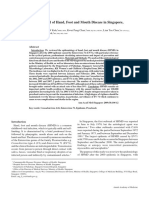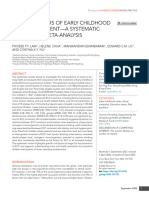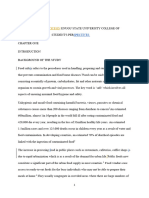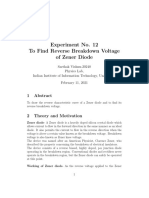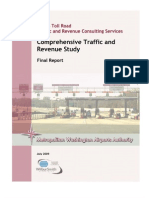Article Outbreak Nur
Article Outbreak Nur
Uploaded by
2021459072Copyright:
Available Formats
Article Outbreak Nur
Article Outbreak Nur
Uploaded by
2021459072Original Title
Copyright
Available Formats
Share this document
Did you find this document useful?
Is this content inappropriate?
Copyright:
Available Formats
Article Outbreak Nur
Article Outbreak Nur
Uploaded by
2021459072Copyright:
Available Formats
Outbreak Investigation Report
Outbreak of foodborne disease in a
boarding school, Negeri Sembilan state,
Malaysia, 2021
Nur Nadiatul Asyikin Bujang,a,b Mohd Shahrol Abd Wahil,c Siti Aishah Abas,a,d Khairul Hafidz Alkhair Khairul Amin,a,e
Nadiatul Ima Zulkifli,a Sharina Mohd Shah,a Nurul Fazilah Aziz,a Syuaib Aiman Amir Kamarudin,a Veshny Ganesan,a
Nur Azieanie Zainuddin,a Muhamad Hazizi Muhamad Hasani,a Noor Khalili Mohd Alia and Mohamad Paid Yusofa
Correspondence to Nur Nadiatul Asyikin Bujang (email: nadiatulasyikin@gmail.com)
Objective: Foodborne disease is a significant global public health concern, with Bacillus cereus being a frequent cause of
outbreaks. However, due to the relatively mild symptoms caused by infection with B. cereus, the shorter duration of illness
and the challenges of testing for it in both stool and food samples, outbreaks are often underreported. This report describes
the epidemiology of cases of foodborne illness, the causative agent and risk factors associated with an outbreak in a boarding
school in Seremban district, Negeri Sembilan state, Malaysia, that occurred in November 2021.
Methods: Epidemiological, environmental and laboratory investigations were performed. A case was defined as any person
with abdominal pain, vomiting or diarrhoea that occurred after consuming food served by the canteen at the school. The data
were analysed using Microsoft Excel and the Statistical Package for the Social Sciences (SPSS).
Results: A total of 152 cases were identified among the 597 students, giving an attack rate of 25.5%. All cases were
females aged 13–17 years. They presented with abdominal pain (100%), nausea (97.4%, 148), vomiting (78.3%, 119)
or diarrhoea (61.8%, 94), or a combination of these. The mode of transmission of the outbreak was a continual common
source. The foods associated with becoming a case were beef rendang (a dry curry) (odds ratio [OR]: 20.54, 95% CI: 4.89–
86.30), rice (OR: 19.62, 95% CI: 2.62–147.01), rice cubes (OR: 18.17, 95% CI: 4.31–76.55) and vermicelli (OR: 17.02,
95% CI: 4.03–71.86). Cross-contamination and inadequate thawing and storage temperatures contributed to the outbreak.
Discussion: This outbreak of foodborne illness at a boarding school was likely caused by B. cereus. The findings highlight
the importance of proper food preparation, temperature monitoring, hygiene practices among food handlers and compliance
with food safety guidelines.
F
oodborne diseases continue to be a public health by 4 (22.2%) at primary schools and 3 (16.7%) at
concern globally, contributing to morbidity and colleges.3
mortality, and associated with substantial economic
costs.1 During the past decade, the national annual Food poisoning associated with Bacillus cereus
incidence of foodborne diseases in Malaysia has been causes diarrhoea or vomiting,4 which is generally mild
decreasing, with the incidence reported as 50.1/100 000 and self-limiting. Emetic syndrome develops upon in-
population in 2019.2 Data from e-Wabak, the gesting the preformed toxin in contaminated foods such
communicable disease monitoring system run by the as rice or rice products.4,5 Diarrhoeal syndrome, com-
Ministry of Health in Malaysia, reported 46 outbreaks of monly associated with contaminated fish, vegetables
foodborne disease in Seremban district, Negeri Sembilan or meat, is caused by heat-labile toxins, which have a
state, between 2017 and 2021, with 18 (39.1%) longer incubation period.5,6 The incubation period for the
involving educational institutions. Eleven (61.1%) of emetic syndrome is 0.5 to 6 hours, and for diarrhoeal
these outbreaks occurred at secondary schools, followed syndrome it ranges from 8 to 16 hours.7 B. cereus can
a
Seremban District Health Office, Ministry of Health, Seremban, Negeri Sembilan, Malaysia.
b
Department of Social and Preventive Medicine, Faculty of Medicine, Universiti Malaya, Kuala Lumpur, Malaysia.
c
Disease Control Division, Ministry of Health, Putrajaya, Malaysia.
d
Department of Public Health and Population Medicine, Faculty of Medicine, Universiti Teknologi MARA, Shah Alam, Selangor, Malaysia.
e
Department of Community Health, Faculty of Medicine and Health Sciences, Universiti Putra Malaysia, Serdang, Selangor, Malaysia.
Published: 30 September 2023
doi: 10.5365/wpsar.2023.14.3.1043
https://ojs.wpro.who.int/ WPSAR Vol 14, No 3, 2023 | doi: 10.5365/wpsar.2023.14.3.1043 1
Bacillus cereus outbreak in Seremban, Malaysia Bujang et al
withstand unfavourable conditions8 and survives cook- using convenience sampling. The control group was
ing processes, forming spores that can multiply and defined as those who consumed the same food but did
produce toxins in cooked rice.9 not experience any symptoms.
On 22 November 2021, the Seremban District The attack rate of all students was determined,
Health Office was notified by a local hospital about and the odds ratio (OR) was calculated for all reported
cases of food poisoning occurring among boarding food exposures. P values were calculated using Fisher’s
school students. The outbreak was confirmed by the exact test, with statistical significance defined as
rapid assessment team, consisting of doctors and P<0.05. The data were verified by cross-checking with
environmental health assistant officers. The aim of health-care facility and school records. Then the data
this report is to describe the epidemiology of the were transformed into a line list using Microsoft Excel
outbreak, the steps taken to determine the causative (2021). All data were collected in hardcopy form and
pathogen and the contaminated foods and risk fac- kept confidential in locked storage by the Seremban
tors, and highlight recommendations to prevent future District Health Office. Data were analysed using the
outbreaks. IBM Statistical Package for the Social Sciences (SPSS)
version 26 (Chicago, IL, USA).
METHODS
Laboratory investigation
Outbreak location
Samples were collected for testing on 22 November 2021.
The outbreak occurred in a secondary-level boarding Proxy food samples, hand swabs from food handlers
school attended by 597 female students in Seremban and swabs from kitchen utensils were tested by culture
district, Negeri Sembilan state, an urban area in and sensitivity for B. cereus, Escherichia coli, coliform
Malaysia. bacteria, Salmonella species and Staphylococcus aureus.
Rectal swabs from patients and food handlers were tested
Epidemiological investigation for enteric pathogens by culture and for sensitivity. Test
results were obtained from the Public Health Laboratory
A case was defined as any person who developed Information System.
abdominal pain, vomiting or diarrhoea after consuming
any food or drinks at the boarding school canteen from Environmental investigation
19 November 2021 at 06:30 to 21 November 2021
at 22:00. Active case-finding was conducted through An environmental investigation was conducted to assess
face-to-face interviews, guided by a standardized Min- the physical environment by examining factors such as
istry of Health food poisoning questionnaire. Data were the water source, food storage areas, sanitation practices,
gathered about the sociodemographic characteristics of ventilation systems and other possible sources of con-
the cases, their symptoms, time of symptom onset and tamination. The food preparation process was assessed
food consumption history. Records from government and using Hazard Analysis Critical Control Point standards.
private health-care facilities were reviewed to identify Food handlers were questioned about their typhoid vac-
similar cases that may have been linked to the outbreak cination status and their attendance at food handling
of foodborne illness through formal requests made to the courses, as guided by the Ministry of Health’s risk-based
relevant authorities. food premises inspection form, amendment 2018.
An unmatched case–control study was conducted RESULTS
due to the challenges of recruiting participants during
the coronavirus disease (COVID-19) pandemic and of Epidemiological investigation
conducting a field study. Individuals were eligible for
inclusion if they had been exposed to the food prepared A total of 152 cases were identified among the 597 stu-
and served by the boarding school canteen during dents who lived at the boarding school, giving an attack
19 to 21 November 2021. Participants were recruited rate of 25.5%. For the case–control study, there were
2 WPSAR Vol 14, No 3, 2023 | doi: 10.5365/wpsar.2023.14.3.1043 https://ojs.wpro.who.int/
Bujang et al Bacillus cereus outbreak in Seremban, Malaysia
152 cases and 200 controls, for a ratio of 1:1.3. All cases and had received typhoid vaccinations and attended
were female and aged 13–17 years. They presented with food safety training.
abdominal pain (100%), nausea (97.4%, 148), vomiting
(78.3%, 119) or diarrhoea (61.8%, 94), or a combination Laboratory investigation
of these. All cases were treated as outpatients and none
died. The samples collected included five proxy foods (stir fry
macaroni, white bread, fried chicken, soto vermicelli and
The epidemic curve suggests an outbreak with chocolate cake), one sample of boiled water, 24 rectal
a continual source, as indicated by the multiple peaks swabs from 17 cases and seven food handlers, seven
(Fig. 1), with a suggested first exposure at breakfast on swabs from food preparers’ hands, seven environmental
20 November 2021. The epidemic curve also suggests samples and 15 water samples from drinking-water
that there was ongoing exposure because the onset dispensers at the school. The laboratory investigation
of symptoms for the first case was on 20 November yielded B. cereus (<4000 colony forming units [CFU]/g)
2021 at 16:00, and the onset for the last case was on from the hand swab of one food preparer (staff member A)
22 November 2021 at 07:30. who worked the morning shifts on 20 and 21 November.
Samples from two chopping boards also yielded
The food served by the canteen operator during B. cereus and E. coli (Table 2). The proxy food samples
20 and 21 November 2021 with the highest ORs included and the rice-scooping spoon yielded coliforms (Table 2).
beef rendang and rice cubes, served during breakfast on
20 November (OR: 20.54, 95% CI: 4.89–86.30 for the Outbreak control measures
beef rendang; OR: 19.62, 95% CI: 2.62–147.01 for the
rice cubes); white rice served during lunch (OR: 9.64, Following the outbreak, all activities at the canteen were
95% CI: 4.32–76.55); white rice and chicken curry temporarily suspended in accordance with Malaysia’s
served during dinner on the same day (OR: 19.62, 95% Infectious Disease Control Act 1988. This allowed the
CI: 2.62–147.01); and vermicelli and spicy soy sauce kitchen operator to take necessary measures to ensure
served during breakfast on 21 November (OR: 17.02, compliance with food and hygiene regulations before
95% CI: 4.03–71.86) (Table 1). Leftover food was not resuming operations. Food handlers were reminded to
consumed by students or staff. monitor temperatures closely, while the district health
educator delivered talks to the food handlers and stu-
Environmental investigation dents as well as distributed informational pamphlets to
students and teachers. To prevent future outbreaks, it is
The assessment of food processing showed a important to emphasize how to handle food safely and
temperature monitoring violation, as there was no to educate food handlers, school administrators and stu-
temperature monitoring when raw food was received or dents about food safety as well. A subsequent inspection
during its storage in the chiller and freezer. The beef was done to ensure that all necessary actions had been
was defrosted for less than 1 hour. The beef was boiled taken promptly.
in 40-kg quantities in a cauldron without temperature
monitoring for 20 minutes, which may have contributed DISCUSSION
to uneven and insufficient heating. The rice was washed
before cooking and was cooked in a large pot, with Investigating outbreaks of foodborne illnesses enables
approximately 5 kg rice per pot. It was cooked fresh for possible sources of infection to be identified. This
each meal and was not served again. outbreak was most likely caused by B. cereus cross-
contamination and poor temperature monitoring. In this
During inspection of the premises, flies were outbreak, there were cases with emetic and diarrhoeal
noted in the kitchen due to non-functioning fly traps. symptoms, suggesting a mixed source of B. cereus.5
Hand-washing stations were not equipped with soap.
Otherwise, the overall cleanliness of the premises was The longer incubation periods observed and the
rated at 96.6%. All 14 food handlers were asymptomatic continual common source pattern evidenced by the
https://ojs.wpro.who.int/ WPSAR Vol 14, No 3, 2023 | doi: 10.5365/wpsar.2023.14.3.1043 3
Bacillus cereus outbreak in Seremban, Malaysia Bujang et al
Fig. 1. Epidemic curve of an outbreak of foodborne illness in a boarding school canteen, by date and time of
symptom onset, Seremban district, Negeri Sembilan state, Malaysia, 20–22 November 2021
Table 1. Case–control analysis of an outbreak of foodborne illness in a boarding school canteen, Seremban district,
Negeri Sembilan state, Malaysia, 20–22 November 2021a
Cases (n = 152) Controls (n = 200)
Type of food Odds ratio (95% CI) P
Exposed Not exposed Total Exposed Not exposed Total
20 November 2021 – Breakfast, 06:30 to 07:30
Rice cubesb 150 2 152 161 39 200 18.17 (4.31–76.55) < 0.001
Beef rendang c
150 2 152 157 43 200 20.54 (4.89–86.30) < 0.001
Peanut gravy 148 4 152 140 60 200 15.86 (5.61–44.78) < 0.05
Malted chocolate drink 147 5 152 129 71 200 16.18 (6.34–41.31) < 0.05
20 November 2021 – Lunch, 12:30 to 13:30
White rice 151 1 152 188 12 200 9.64 (1.24–74.96) < 0.05
Fried spicy stuffed
151 1 152 187 13 200 10.50 (1.36–81.16) < 0.05
torpedo scad
Turmeric fried prawns 150 2 152 181 19 200 7.87 (1.80–34.35) < 0.05
Cabbage cooked in coconut
150 2 152 179 21 200 8.80 (2.03–38.14) < 0.05
broth
20 November 2021 – Dinner, 18:00 to 19:00
White rice 151 1 152 177 23 200 19.62 (2.62–147.01) < 0.05
Chicken curry 151 1 152 177 23 200 19.62 (2.62–147.01) < 0.05
Stir fry vegetables 149 2 152 170 30 200 13.15 (3.09–55.95) < 0.05
Red apple 146 6 152 170 30 200 4.29 (1.74–10.60) < 0.05
Plain water 150 2 152 170 30 200 13.24 (3.11–56.32) < 0.05
21 November 2021 – Breakfast, 06:30 to 07:30
Vermicelli 150 2 152 163 37 200 17.02 (4.03–71.86) < 0.05
Spicy soy sauce 150 2 152 163 37 200 17.02 (4.03–71.86) < 0.05
Malted drinks 147 5 152 150 50 200 9.8 (3.80–25.27) < 0.05
CI: confidence interval.
a
Foods in bold are suspected to have been associated with the outbreak.
b
Rice cubes are compacted rice that is boiled and subsequently cut into small cubes.
c
Beef rendang is a dry curry that is prepared using coconut milk and spices.
4 WPSAR Vol 14, No 3, 2023 | doi: 10.5365/wpsar.2023.14.3.1043 https://ojs.wpro.who.int/
Bujang et al Bacillus cereus outbreak in Seremban, Malaysia
Table 2. Laboratory results from an outbreak of foodborne illness in a boarding school canteen, Seremban
district, Negeri Sembilan state, Malaysia, from samples collected on 22 November 2021
No. of Test result
Type of specimen Test and method Organism identified
samples Positive Negative
Samples from cases and food handlers
Hand swabs Bacillus cereus (<4000
7 1 6
(food handler) CFU/g) from staff member A
Culture and sensitivity for enteric pathogens
Rectal swabs (food
24 0 24 –
handlers and cases)
Samples from food and water
Stir fry macaroni 1 1 0 Coliform (1300 CFU/g)
B. cereus (ISO 7932:2004 [E])a
White bread 1 1 0 Coliform (30 000 CFU/g)
Escherichia coli (AOAC 991.14)
Fried chicken Coliform (AOAC 991.14) 1 0 1 –
Salmonella species (ISO 6579-1:2017 [E])
Soto vermicelli b
1 0 1 –
Staphylococcus aureus (AOAC 2003.07-2006)
Chocolate cake 1 0 1 –
Water (from drinking-water
1 0 1 –
dispenser)
Coagulase-positive Staphylococci
Drinking-water dispenser (ISO 6888-1:1999/ Amd.1.2003 [E]) 1 0 1 –
Filtered water dispenser 1 0 1 –
Samples from kitchen utensils
B. cereus (<4000 CFU/g)
Cutting board (sample 1) E. coli (700 CFU/g)
Coliform (350 000 CFU/g)
B. cereus (<4000 CFU/g)
Cutting board (sample 2) B. cereus (ISO 7932:2004 [E]) 1 1 0 E. coli (100 CFU/g)
E. coli (AOAC 991.14) Coliform (34 000 CFU/g)
Coliform (AOAC 991.14)
Rice spoon S. aureus (AOAC 2003.07-2006) 1 1 0 Coliform (6500 CFU/g)
Ladle 1 0 1 –
Tip of water bottle 1 0 1 –
Pan surface 1 0 1 –
AOAC: Association of Official Analytical Collaboration International; CFU: colony forming units; ISO: International Organization for Standardization; –: indicates no findings.
a
The letter E after an ISO standard indicates that it was published in English.
b
Soto vermicelli is a plain soup eaten with vermicelli noodles.
epidemiological curve, characterized by a gradual rise in allow B. cereus to survive the cooking process and con-
the number of cases and numerous peaks over time, can tinue multiplying,10 which could explain the high OR for
be explained by multiple contamination incidents occur- beef rendang. Multiple factors commonly contribute to
ring over 2 days. The food could have been continually outbreaks of foodborne illness, especially those related to
contaminated by staff member A, kitchen equipment or improper storage (i.e. refrigeration) and failure to maintain
contaminated food. The self-service buffet style of food proper temperatures.11 Other sauce-based dishes, such
service during which students have their meals in groups as chicken curry and spicy soy sauce, also had a high OR
in the dining hall may also have contributed to this type of since they were served with rice. Rice was often served
epidemiological curve and could have facilitated possible for breakfast, lunch and dinner on the dates around the
contamination by students. outbreak occurrence, so it is possible that rice was also
responsible for this outbreak.
The ORs associated with the food should be inter-
preted with caution due to the wide confidence intervals, Despite swabbing workers’ hands and kitchen equip-
which make it difficult to determine which foods were ment, only low numbers of CFUs were found; however,
most strongly associated with illness. However, not the positivity still indicates contamination since low num-
monitoring the temperature of the raw meat could also bers of B. cereus have caused outbreaks.12 To improve
https://ojs.wpro.who.int/ WPSAR Vol 14, No 3, 2023 | doi: 10.5365/wpsar.2023.14.3.1043 5
Bacillus cereus outbreak in Seremban, Malaysia Bujang et al
the efficacy of hand-washing and reduce the number of Conflicts of interest
B. cereus spores, soap should be used and hands should
be washed for at least 20 seconds.13,14 Drying hands The authors have no conflicts of interest to declare.
with disposable towels instead of cloth towels can also
reduce the risk of cross-contamination.15 The presence Ethics statement
of E. coli and coliforms suggests poor hygiene practices.
Ethical approval was obtained from the Medical Research
The study has limitations that make it difficult to and Ethics Committee, Ministry of Health, Malaysia (no.
definitively confirm that B. cereus caused the outbreak. NMRR-22-00798-WMX).
None of the food items from the days on which con-
tamination likely occurred were available for testing; Funding
instead, proxy food samples were used. When tested,
these proxy samples were negative for B. cereus toxins. None.
In terms of the statistical analyses, multivariable analysis
was not performed, and the assessment of potentially References
contaminated food was conducted solely using univari-
1. Jaffee S, Henson S, Unnevehr L, Grace D, Cassou E. The safe
able analysis. Ideally, a cohort study should have been food imperative: accelerating progress in low- and middle-in-
conducted, but a case–control design was adopted due come countries. Washington (DC): World Bank; 2018. Available
to the limited number of staff and stringent standard from: http://hdl.handle.net/10986/30568, accessed 3 February
2023.
operating procedures implemented during the COVID-19
2. Compendium of environment statistics, Malaysia 2020. Putrajaya:
pandemic. Recall bias may exist due to the retrospective Department of Statistics, Malaysia; 2020: page 223. Available
nature of participants providing a history of their food from: https://newss.statistics.gov.my/newss-portalx/ep/epProduct-
FreeDownloadSearch.seam, accessed 1 February 2023.
intake, and potential confounders were not adjusted for
statistically. Due to the limitations identified in this study, 3. Vector-borne disease and outbreak reporting system. Putra-
jaya: Ministry of Health, Malaysia; 2022. Available from: http://
the definitive causative agent of the foodborne outbreak vekpro.moh.gov.my/vekpro/index.htm, accessed 10 December
is not confirmed. 2022.
4. Ehling-Schulz M, Guinebretiere M-H, Monthán A, Berge O,
Fricker M, Svensson B. Toxin gene profiling of enterotoxic and emet-
In conclusion, this outbreak investigation high- ic Bacillus cereus. FEMS Microbiol Lett. 2006;260(2):232–40.
lights the need for proper food handling, temperature doi:10.1111/j.1574-6968.2006.00320.x pmid:16842349
monitoring and hygiene practices. B. cereus most likely 5. Gram-positive bacteria. In: Lampel K, Al-Khaldi S, Cahill S, editors.
caused the outbreak through cross-contamination, Bad bug book: handbook of foodborne pathogenic microorganisms
and natural toxins. 2nd ed. Silver Spring (MD): Center for Food Safe-
while the presence of E. coli indicated poor hygiene ty and Applied Nutrition, U.S. Food and Drug Administration; 2012.
standards. It is necessary to ensure there are strict Available from: https://www.fda.gov/media/83271/download, ac-
cessed 27 February 2023.
enforcement of and more effective control measures,
6. Jeßberger N, Rademacher C, Krey VM, Dietrich R, Mohr A-K,
continual training and frequent spot inspections to
Böhm M-E, et al. Simulating intestinal growth conditions en-
identify and address any violations in food handling hances toxin production of enteropathogenic Bacillus cereus.
and hygiene practices. Front Microbiol. 2017;8:627. doi:10.3389/fmicb.2017.00627
pmid:28446903
Acknowledgements 7. Rouzeau-Szynalski K, Stollewerk K, Messelhäusser U,
Ehling-Schulz M. Why be serious about emetic Bacillus ce-
reus: cereulide production and industrial challenges. Food
The authors thank the Director-General of the Ministry Microbiol. 2020;85:103279. doi:10.1016/j.fm.2019.103279
of Health of Malaysia for his permission to publish this pmid:31500702
article. The authors give special thanks to staff from the 8. Yu S, Yu P, Wang J, Li C, Guo H, Liu C, et al. A study on prev-
alence and characterization of Bacillus cereus in ready-to-eat
Seremban District Health Office who were involved in foods in China. Front Microbiol. 2020;10:3043. doi:10.3389/
this outbreak investigation. fmicb.2019.03043 pmid:32010099
6 WPSAR Vol 14, No 3, 2023 | doi: 10.5365/wpsar.2023.14.3.1043 https://ojs.wpro.who.int/
Bujang et al Bacillus cereus outbreak in Seremban, Malaysia
9. Osimani A, Aquilanti L, Clementi F. Bacillus cereus foodborne out- 13. Dorotíková K, Kameník J, Bogdanovičová K, Křepelová S, Strejček J,
breaks in mass catering. Int J Hospit Manag. 2018;72:145–53. Haruštiaková D. Microbial contamination and occurrence of Ba-
doi:10.1016/j.ijhm.2018.01.013 cillus cereus sensu lato, Staphylococcus aureus, and Escherichia
10. Tewari A, Singh SP, Singh R. Incidence and enterotoxigenic profile coli on food handlers’ hands in mass catering: comparison of the
of Bacillus cereus in meat and meat products of Uttarakhand, India. glove juice and swab methods. Food Control. 2022;133:108567.
J Food Sci Technol. 2015;52(3):1796–801. doi:10.1007/s13197- doi:10.1016/j.foodcont.2021.108567
013-1162-0 pmid:25745259 14. Sasahara T, Hayashi S, Hosoda K, Morisawa Y, Hirai Y. Comparison
11. Panisello PJ, Rooney R, Quantick PC, Stanwell-Smith R. Ap- of hand hygiene procedures for removing Bacillus cereus spores.
plication of foodborne disease outbreak data in the develop- Biocontrol Sci. 2014;19(3):129–34. doi:10.4265/bio.19.129
ment and maintenance of HACCP systems. Int J Food Microbiol. pmid:25252644
2000;59(3):221–34. doi:10.1016/S0168-1605(00)00376-7
15. Yap M, Chau ML, Hartantyo SHP, Oh JQ, Aung KT, Gutiérrez RA, et
pmid:11020042
al. Microbial quality and safety of sushi prepared with gloved or bare
12. Carroll LM, Wiedmann M, Mukherjee M, Nicholas DC, hands: food handlers’ impact on retail food hygiene and safety. J
Mingle LA, Dumas NB, et al. Characterization of emetic and Food Prot. 2019;82(4):615–22. doi:10.4315/0362-028X.JFP-18-
diarrheal Bacillus cereus strains from a 2016 foodborne out- 349 pmid:30907665
break using whole-genome sequencing: addressing the mi-
crobiological, epidemiological, and bioinformatic challenges.
Front Microbiol. 2019;10:144. doi:10.3389/fmicb.2019.00144
pmid:30809204
https://ojs.wpro.who.int/ WPSAR Vol 14, No 3, 2023 | doi: 10.5365/wpsar.2023.14.3.1043 7
You might also like
- Introduction of Guest SpeakerDocument2 pagesIntroduction of Guest SpeakerJewel Mae Mercado91% (11)
- 140 Recommended Guidelines For Offshore Loading Shuttle Tankers PDFDocument69 pages140 Recommended Guidelines For Offshore Loading Shuttle Tankers PDFChowdhury FatemaNo ratings yet
- RBEC PELC Science and HealthDocument51 pagesRBEC PELC Science and Healthglenn0104No ratings yet
- 356908-Prac Tool - Mood Diary WorksheetDocument2 pages356908-Prac Tool - Mood Diary WorksheetCvetanka BurzevskaNo ratings yet
- Gatsby False Prophet of The American Dream EssayDocument2 pagesGatsby False Prophet of The American Dream EssayKarichmarie Marrero RodriguezNo ratings yet
- Jurnal ToksikologiDocument5 pagesJurnal ToksikologiSutari Oktavia SimanjuntakNo ratings yet
- Kejadian Luar BiasaDocument5 pagesKejadian Luar BiasafudinpoxNo ratings yet
- Pregnant Women in West GojjamDocument10 pagesPregnant Women in West Gojjambluish oceanNo ratings yet
- Campy IJMMmanuscriptDocument7 pagesCampy IJMMmanuscriptAri Tri UtamiNo ratings yet
- 1 s2.0 S0956713514005003 MainDocument6 pages1 s2.0 S0956713514005003 MainBrayan Aguiar MendozaNo ratings yet
- Keamanan Pangan Dimasa PandemiDocument5 pagesKeamanan Pangan Dimasa PandemiAnita Dewi MoelyaningrumNo ratings yet
- Systematic Review of Associations Between Gut Microbiome Composition and Stunting in Under-Ve ChildrenDocument13 pagesSystematic Review of Associations Between Gut Microbiome Composition and Stunting in Under-Ve ChildrenSafira TasyaNo ratings yet
- Urindo Referensi 174 290 1 SMDocument9 pagesUrindo Referensi 174 290 1 SMAisyah Eka PutriNo ratings yet
- Endocrinology, Metabolism and NutritionDocument6 pagesEndocrinology, Metabolism and NutritionScivision PublishersNo ratings yet
- Diarrhea Prevention Through Food Safety EducationDocument4 pagesDiarrhea Prevention Through Food Safety Educationceking99No ratings yet
- Identification and Probability of Illness of S. Aureus Contaminated Food For School ChildrenDocument6 pagesIdentification and Probability of Illness of S. Aureus Contaminated Food For School ChildrenLim Lee ThongNo ratings yet
- Predicting Relationship Between Food-Borne Disease Information-Adequacy and Food Handling Practices Among Food-Handlers in Selected Restaurants in Ggaba Kampala, Makindye Division UgandaDocument8 pagesPredicting Relationship Between Food-Borne Disease Information-Adequacy and Food Handling Practices Among Food-Handlers in Selected Restaurants in Ggaba Kampala, Makindye Division UgandaInternational Journal of Innovative Science and Research TechnologyNo ratings yet
- Evaluation of Basic Knowledge On Food Safety and Food Handling Practices Amongst Migrant in MalaysiaDocument10 pagesEvaluation of Basic Knowledge On Food Safety and Food Handling Practices Amongst Migrant in MalaysiaSiska PratiwiNo ratings yet
- BelizarioDocument8 pagesBelizarioBryan Christopher Co LaoNo ratings yet
- Association Beteween Intestinal Helmintihic Infections and Anaemia Status in Preschool ChildrenDocument5 pagesAssociation Beteween Intestinal Helmintihic Infections and Anaemia Status in Preschool ChildrenJulio LujánNo ratings yet
- 1 1 71Document8 pages1 1 71Medical JournalNo ratings yet
- Rapid Methods For The Detection of Foodborne Bacterial PathogensDocument19 pagesRapid Methods For The Detection of Foodborne Bacterial PathogensIoana MoldovanNo ratings yet
- Purposive Sampling. Pengumpulan Data Dengan Cara Pengisian Kuesioner. Analisis Data Univariat DanDocument10 pagesPurposive Sampling. Pengumpulan Data Dengan Cara Pengisian Kuesioner. Analisis Data Univariat DanYeng PernandesNo ratings yet
- Giardiasis and Poor Vitamin A Status Among Aboriginal School Children in Rural MalaysiaDocument5 pagesGiardiasis and Poor Vitamin A Status Among Aboriginal School Children in Rural Malaysiaevandere19No ratings yet
- International Journal of Trend in Scientific Research and Development (IJTSRD)Document8 pagesInternational Journal of Trend in Scientific Research and Development (IJTSRD)Editor IJTSRDNo ratings yet
- GastroenteritisDocument9 pagesGastroenteritisgaloh0% (1)
- Clinical-Epidemiological Considerations Regarding Primary Peptic Ulcer in Children - 5 Years Retrospective StudyDocument10 pagesClinical-Epidemiological Considerations Regarding Primary Peptic Ulcer in Children - 5 Years Retrospective StudySilvia PoamăneagrăNo ratings yet
- WORK 1Document18 pagesWORK 1Idris abdulrazakNo ratings yet
- Epidemiology and Determinants of Soil-Transmitted Helminthiases Among Selected Primary School Children in Tuguegarao City, Cagayan, Philippines: A Cross-Sectional StudyDocument4 pagesEpidemiology and Determinants of Soil-Transmitted Helminthiases Among Selected Primary School Children in Tuguegarao City, Cagayan, Philippines: A Cross-Sectional StudyIJEAB JournalNo ratings yet
- Cambridge University Press Epidemiology and InfectionDocument7 pagesCambridge University Press Epidemiology and InfectionMegbaruNo ratings yet
- Staphylococcus EnterotoxinDocument13 pagesStaphylococcus EnterotoxinArri KurniawanNo ratings yet
- RESEARCHDocument8 pagesRESEARCHErica RosislifeNo ratings yet
- Evaluation of Some Hotel Kitchen Staff On Their Knowledge On Food Safety and Kitchen Hygiene in The Kumasi MetropolisDocument6 pagesEvaluation of Some Hotel Kitchen Staff On Their Knowledge On Food Safety and Kitchen Hygiene in The Kumasi MetropolisIwan Suryadi MahmudNo ratings yet
- Association Between Nutritional Status and Severity of Pneumonia Among Children Under Five Years Attending Wangaya District HospitalDocument7 pagesAssociation Between Nutritional Status and Severity of Pneumonia Among Children Under Five Years Attending Wangaya District HospitalchairulNo ratings yet
- Why So Many Negative Coproculture About 2329 Corocultures Carried Out at The Charles de Gaulle Pediatric Hospital Center in HospitDocument4 pagesWhy So Many Negative Coproculture About 2329 Corocultures Carried Out at The Charles de Gaulle Pediatric Hospital Center in HospitScivision PublishersNo ratings yet
- Vol. 3 No. 02 (2024) 102-117Document16 pagesVol. 3 No. 02 (2024) 102-117muradchy321No ratings yet
- Prevalence and Risk Factors of Helicobacter Pylori Infection in Asymptomatic Chinese Children: A Prospective, Cross-Sectional, Population-Based StudyDocument8 pagesPrevalence and Risk Factors of Helicobacter Pylori Infection in Asymptomatic Chinese Children: A Prospective, Cross-Sectional, Population-Based StudyyundaNo ratings yet
- The Associationof Nematode Infectionandthe Academic Performanceof Grade IPupilsin Sampalukan Elementary School Caloocan CityDocument6 pagesThe Associationof Nematode Infectionandthe Academic Performanceof Grade IPupilsin Sampalukan Elementary School Caloocan CityCyril Danica LimareNo ratings yet
- Ijphs Fix B.inggrisDocument14 pagesIjphs Fix B.inggrisrizkimNo ratings yet
- A Cross Sectional Study On Food Safety Knowledge Among Adult ConsumersDocument8 pagesA Cross Sectional Study On Food Safety Knowledge Among Adult ConsumersAlina ShahidNo ratings yet
- 6.Document6 pages6.CatarinaBarros30No ratings yet
- 1 اول بحثDocument10 pages1 اول بحثSara ELsherifNo ratings yet
- Diarrea en QuimioterapiaDocument6 pagesDiarrea en QuimioterapiaPaola DiazNo ratings yet
- Sistem Rekomendasi Menu Harian Makanan P 40af3fdcDocument14 pagesSistem Rekomendasi Menu Harian Makanan P 40af3fdcDavien UtoyoNo ratings yet
- البحث المنشورDocument8 pagesالبحث المنشورRiyad.atshan.ikuNo ratings yet
- Food Safety Attitude and Practice QuestiDocument7 pagesFood Safety Attitude and Practice QuestiHamid AshrafNo ratings yet
- Original Research ArticleDocument5 pagesOriginal Research ArticleNouraNo ratings yet
- Hungx BuiDocument92 pagesHungx BuimustikaarumNo ratings yet
- Ang LW Et Al. Epidemiology and Control of Hand, Foot and Mouth Disease in Singapore, 2001-2007. Ann Acad Med Singapore 2009 38 106-12Document7 pagesAng LW Et Al. Epidemiology and Control of Hand, Foot and Mouth Disease in Singapore, 2001-2007. Ann Acad Med Singapore 2009 38 106-12chaer assofiNo ratings yet
- The Role of Regulatory Mechanisms and Environmental Parameters in Staphylococcal Food Poisoning and Resulting Challenges To Risk AssessmentDocument13 pagesThe Role of Regulatory Mechanisms and Environmental Parameters in Staphylococcal Food Poisoning and Resulting Challenges To Risk AssessmentSuwoko AgustinNo ratings yet
- Infectious Diseases: Bacterial Sensitivity To Fosfomycin in Pregnant Women With Urinary InfectionDocument5 pagesInfectious Diseases: Bacterial Sensitivity To Fosfomycin in Pregnant Women With Urinary InfectionDewa Made Sucipta PutraNo ratings yet
- medip,+IJCP-2356+O (3)Document6 pagesmedip,+IJCP-2356+O (3)Smile GandhiNo ratings yet
- 1 s2.0 S153233822200046X MainDocument16 pages1 s2.0 S153233822200046X MainDANTE DELEGUERYNo ratings yet
- Main Main - Final - Result - Project - 2Document65 pagesMain Main - Final - Result - Project - 2Ebuka AniNo ratings yet
- 12 - 87 - 95 - UJMR 040 BashirDocument9 pages12 - 87 - 95 - UJMR 040 BashirUMYU Journal of Microbiology Research (UJMR)No ratings yet
- Kontaminasi Bakteri Eschericia Coli Pada Makanan Dan Minuman Penjual Jajanan Di Lingkungan Pendidikan Muhammadiyah Limau, Jakarta SelatanDocument11 pagesKontaminasi Bakteri Eschericia Coli Pada Makanan Dan Minuman Penjual Jajanan Di Lingkungan Pendidikan Muhammadiyah Limau, Jakarta SelatanElyda Chartica Shary BoetarboetarNo ratings yet
- Food safety knowledge and hygiene practices among veterinaryDocument5 pagesFood safety knowledge and hygiene practices among veterinaryCatarinaBarros30No ratings yet
- NELSON 3Document11 pagesNELSON 3n.amaniNo ratings yet
- Kubota 2011Document8 pagesKubota 2011Sergio LoaizaNo ratings yet
- DocumentDocument11 pagesDocumentepokayeNo ratings yet
- Food Safety Monitoring andDocument4 pagesFood Safety Monitoring andMVNo ratings yet
- HelminthDocument27 pagesHelminthHelsie DahokloryNo ratings yet
- Environmental Factors Associated With Acute Diarrhea Among Children Under Five Years of Age in Derashe District, Southern EthiopiaDocument10 pagesEnvironmental Factors Associated With Acute Diarrhea Among Children Under Five Years of Age in Derashe District, Southern Ethiopiadefitri sariningtyasNo ratings yet
- Food Protein Induced Enterocolitis (FPIES): Diagnosis and ManagementFrom EverandFood Protein Induced Enterocolitis (FPIES): Diagnosis and ManagementTerri Faye Brown-WhitehornNo ratings yet
- Campylobacteriosis Unveiled: A Multifaceted Exploration of Medical, Nutritional, and Holistic PerspectivesFrom EverandCampylobacteriosis Unveiled: A Multifaceted Exploration of Medical, Nutritional, and Holistic PerspectivesNo ratings yet
- The Present Tense Simple I. Formation RulesDocument14 pagesThe Present Tense Simple I. Formation RulesGigiEnergieNo ratings yet
- Experiment No. 12 To Find Reverse Breakdown Voltage of Zener DiodeDocument7 pagesExperiment No. 12 To Find Reverse Breakdown Voltage of Zener DiodeSarthak VishnuNo ratings yet
- Technical Data DuoTek AODD Pump AF0160 Rev 0.2Document5 pagesTechnical Data DuoTek AODD Pump AF0160 Rev 0.2PERLA BEATRIZ MOCTEZUMA VILLEGASNo ratings yet
- Specification For: British Standard BS 6497:1984Document4 pagesSpecification For: British Standard BS 6497:1984SK Emran AliNo ratings yet
- Checking SIMFEXDocument4 pagesChecking SIMFEXGanesh JagadeeshNo ratings yet
- Books For Children Beginning To ReadDocument19 pagesBooks For Children Beginning To ReadTeresa MagalhãesNo ratings yet
- 25 Words You Didn't Know Were in The DictionaryDocument1 page25 Words You Didn't Know Were in The Dictionary62yykwt4b8No ratings yet
- 5) C1 Coordinate Geometry in The (X, Y) Plane QuestionsDocument21 pages5) C1 Coordinate Geometry in The (X, Y) Plane QuestionsIshy HereNo ratings yet
- Six Thinking HatsDocument20 pagesSix Thinking HatspoojapladdhaNo ratings yet
- Wilbur Smith Traffic - Study - 2009Document215 pagesWilbur Smith Traffic - Study - 2009Terry MaynardNo ratings yet
- Impact of Plastic Formwork Over Conventional FormworkDocument6 pagesImpact of Plastic Formwork Over Conventional FormworkAchmad Zaki Zulkarnain100% (2)
- Tchokov - Gemiú - El Piano, PreparatorioDocument5 pagesTchokov - Gemiú - El Piano, PreparatorioGenara Pajaraca MarthaNo ratings yet
- Bushing Method 1Document11 pagesBushing Method 1khalisha salsabilaNo ratings yet
- Deal Drivers Africa 2014Document44 pagesDeal Drivers Africa 2014Arnaud Dumourier100% (2)
- Final Hyundai Motor Company-Self MadeDocument48 pagesFinal Hyundai Motor Company-Self MadeChandan SrivastavaNo ratings yet
- ZIMMERMAN - Integrated Design Process GuideDocument18 pagesZIMMERMAN - Integrated Design Process GuideLipov UnisNo ratings yet
- Globalization PowerpointDocument41 pagesGlobalization PowerpointArjay Jimenez0% (1)
- Strategy Implementation: Project Report - Hero MotocorpDocument30 pagesStrategy Implementation: Project Report - Hero MotocorpSANYUJ ZADGAONKARNo ratings yet
- Advanced Wireless Power Transfer SystemDocument85 pagesAdvanced Wireless Power Transfer SystemDeepak KNo ratings yet
- Atmel Example ListDocument1 pageAtmel Example ListimenenouvelleNo ratings yet
- Translste Gebhar Scram - 11-35Document25 pagesTranslste Gebhar Scram - 11-35indra purnamaNo ratings yet
- PATHFIT 3 Module 6 Fundametal Dance Postions and StepsDocument35 pagesPATHFIT 3 Module 6 Fundametal Dance Postions and Stepsburgosjeiar19No ratings yet
- Understanding Charts and Graphs - Multiple Choice QuizDocument3 pagesUnderstanding Charts and Graphs - Multiple Choice Quizdeverajenelle5No ratings yet
- Lecture 1 Introduction To MicroprocessorsDocument16 pagesLecture 1 Introduction To MicroprocessorsSaif UddinNo ratings yet
- Toyota RS2000 - User ManualDocument3 pagesToyota RS2000 - User ManualSzelestey Tamás "ToME"No ratings yet
















































